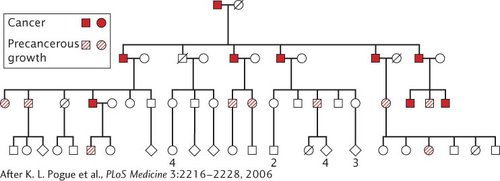Palladin and the Spread of Cancer

Villa designed by Renaissance architect Andrea Palladio, for whom the palladin gene is named. The palladin gene encodes an essential component of a cell’s cytoskeleton; when mutated, palladin contributes to the spread of pancreatic cancer.
[Gianni Dagli Orti/The Art Archive at Art Resource, NY.]
Pancreatic cancer is among the most serious of all cancers. With about 46,000 new cases each year in the United States, it is only the tenth most common form of the disease, but it is the fourth leading cause of death due to cancer, killing more than 39,000 people each year. Most people with pancreatic cancer survive less than 6 months after they are diagnosed; only 5% survive more than five years. A primary reason for pancreatic cancer’s lethality is its propensity to spread rapidly to the lymph nodes and other organs. Most symptoms don’t appear until the cancer is advanced and has invaded other organs. So what makes it so likely to spread?
In 2006, researchers identified a key gene that contributes to the development of pancreatic cancer—an important source of insight into the disease’s aggressive nature. Geneticists at the University of Washington in Seattle found a unique family in which nine members over three generations had been diagnosed with pancreatic cancer (Figure 16.1). Nine additional family members had precancerous growths that were likely to develop into pancreatic cancer. In this family, pancreatic cancer was inherited as an autosomal dominant trait.

16.1 Pancreatic cancer is inherited as an autosomal dominant trait in a family that possesses a mutated palladin gene.
[After K. L. Pogue et al., PLoS Medicine 3:2216–2228, 2006.]
By using gene-mapping techniques, geneticists determined that the gene causing pancreatic cancer in the family was located within a region on the long arm of chromosome 4. Unfortunately, this region encompasses 16 million base pairs and includes 250 genes. To determine which of the 250 genes in the delineated region might be responsible for cancer in the family, researchers designed a unique microarray (see Chapter 15) that contained sequences from the region. They used this microarray to examine gene expression in pancreatic tumors and precancerous growths in family members, as well as in sporadic (nonhereditary) pancreatic tumors in other people and in normal pancreatic tissue from unaffected people. The researchers reasoned that the cancer gene might be overexpressed or underexpressed in the tumors relative to normal tissue. Data from the microarray revealed that the most overexpressed gene in the pancreatic tumors and precancerous growths was a gene encoding a critical component of the cytoskeleton, referred to as the palladin gene. Sequencing demonstrated that those members of the family with pancreatic cancer all had an identical mutation in exon 2 of the palladin gene.
The palladin gene is named for Renaissance architect Andrea Palladio because it plays a central role in the architecture of the cell. The Palladin protein functions as a scaffold for the binding of the other cytoskeletal proteins that are necessary for maintaining cell shape, movement, and differentiation. The ability of a cancer cell to spread is directly related to its cytoskeleton: cells that spread typically have poor cytoskeletal architecture, which enables them to detach easily from a primary tumor mass and migrate through other tissues. To determine whether mutations in the palladin gene affect cell mobility, researchers genetically engineered cells with a mutated copy of the palladin gene and tested the ability of these cells to migrate. The cells with a mutated copy of the palladin gene were 33% more efficient at migrating than were cells with the normal gene, demonstrating that the palladin gene contributes to the ability of pancreatic cancer cells to spread.
Page 428
The discovery of palladin’s link to pancreatic cancer illustrates the power of modern molecular genetics for unraveling the biological nature of cancer. In this chapter, we examine the nature of cancer, a disease that is fundamentally genetic but is often not inherited. We begin by considering the nature of cancer and how multiple genetic alterations are required to transform a normal cell into a cancerous one. We then consider some of the types of genes that contribute to cancer, including oncogenes and tumor-suppressor genes, genes that control the cell cycle, genes encoding DNA-repair systems and telomerase, and genes that, like palladin, contribute to the spread of cancer. To illustrate the processes involved, we take a detailed look at how specific genes contribute to the progression of colon cancer. Next, we discuss chromosome mutations associated with cancer and genomic instability. Finally, we examine the role of viruses in some cancers.

